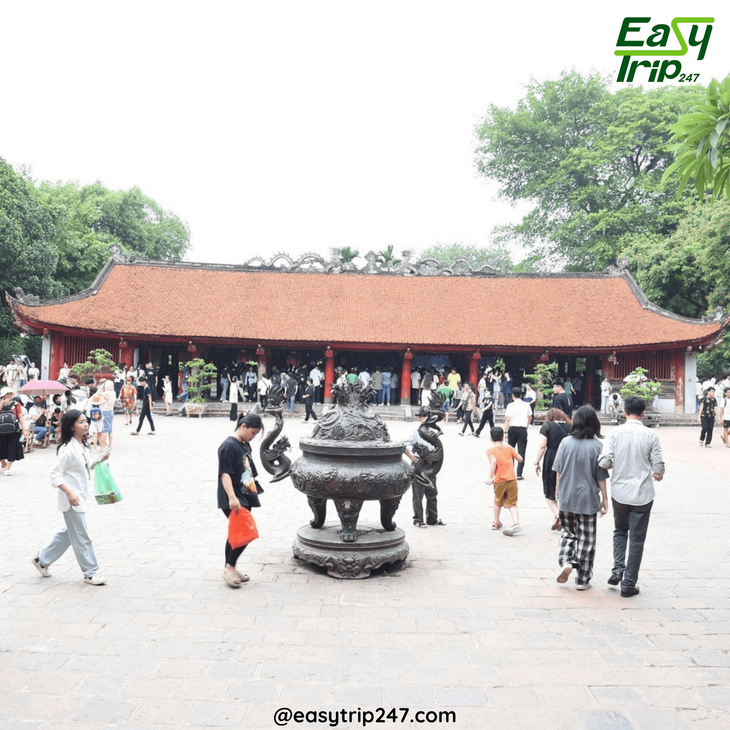The Role of the Temple of Literature in Vietnamese Culture and Education
On
23/06/2025Reading time:
1 min
Summary:
Nestled in the heart of Vietnam’s vibrant capital, the Temple of Literature Hanoi is far more than a historical site. It is a living symbol of Vietnam's enduring reverence for education, knowledge, and cultural identity. Since its founding in 1070 under the reign of Emperor Lý Thánh Tông, the Temple of Literature Hanoi has stood as a proud monument to Confucian ideals, intellectual achievement, and the nation’s scholarly legacy.

The Temple of Literature Hanoi was originally built as a place of worship dedicated to Confucius and his disciples. This dedication reflected the centrality of Confucian thought in Vietnamese society, which emphasized moral integrity, filial piety, and the pursuit of wisdom. However, its significance deepened in 1076, when it became home to the Quốc Tử Giám—Vietnam’s first national university. From that point forward, the Temple of Literature Hanoi evolved into an epicenter of learning, where the elite sons of the nation came to study the Confucian classics and prepare for the imperial examinations.
Education in Vietnam during these early dynasties was not simply a means to personal success—it was seen as a noble calling, a way to serve society through knowledge and virtue. The Temple of Literature Hanoi embodied this ideal, attracting scholars, poets, and philosophers who would go on to become key figures in the royal court and civil service. Many of Vietnam’s most respected historical thinkers and educators once walked its courtyards, recited ancient texts under its pavilions, and etched their names into its legacy.
One of the most iconic features of the Temple of Literature Hanoi is the collection of stone stelae, erected atop stone turtles, each engraved with the names of successful candidates in the imperial exams. These stelae—now recognized by UNESCO as documentary heritage—represent a long and proud tradition of meritocracy. Success in the exams was based on intellect and knowledge rather than lineage or wealth, reinforcing the importance of learning as a vehicle for national development. The Temple of Literature Hanoi thus became a powerful symbol of opportunity, perseverance, and equality through education.
Even after the fall of the monarchy and the transition to a modern state, the symbolic power of the Temple of Literature Hanoi has endured. In today’s Vietnam, where education continues to be one of the most valued aspects of life, the temple serves as a powerful cultural reference point. Every year, thousands of students visit before major exams, praying for good fortune and drawing inspiration from the temple’s scholarly past. The practice of rubbing the stone turtles for luck may be more superstition than study technique, but it underscores the emotional connection Vietnamese people have with this historic site.
Beyond education, the Temple of Literature Hanoi plays a key role in preserving Vietnamese cultural identity. Its architecture is a masterclass in traditional design, blending symmetry, harmony, and symbolism. The five courtyards—each representing a stage of academic and spiritual progression—are carefully arranged to lead visitors on a contemplative journey. From the peaceful Van Lake to the Well of Heavenly Clarity, every feature of the temple tells a story rooted in Vietnamese values and aesthetics.
Art, music, and poetry are also deeply intertwined with the legacy of the Temple of Literature Hanoi. Throughout history, the site has hosted numerous cultural events celebrating classical Vietnamese music, calligraphy, and literature. During the Lunar New Year (Tết), the temple becomes a hub of activity, where scholars and calligraphers offer blessings written in beautiful script to bring prosperity and wisdom in the coming year. These customs highlight the temple’s ongoing function as a bridge between the past and present, linking heritage with daily life.
The Temple of Literature Hanoi also plays a unique role in diplomacy and national pride. Visiting dignitaries, foreign educators, and cultural ambassadors are often brought to the temple to experience Vietnam’s intellectual heart. It is not uncommon for international events related to education and culture to be held within its tranquil grounds, symbolizing Vietnam’s openness to global dialogue while honoring its roots. This cultural diplomacy showcases the Temple of Literature Hanoi as not just a relic of the past but as a beacon for future learning and cooperation.
In modern Vietnam, where education reforms are ongoing and access to schooling has dramatically improved, the spirit of the Temple of Literature Hanoi remains deeply relevant. It reminds the nation that while technology, infrastructure, and globalization shape the future, core values like diligence, respect for learning, and ethical leadership are timeless. Schools across Vietnam continue to instill these principles in students, often referencing the temple as a spiritual and moral guide.
Moreover, the Temple of Literature Hanoi has become an essential educational tool in itself. Its museum and interpretive programs offer rich insights into Vietnam’s educational evolution, Confucian philosophy, and civil service traditions. Teachers and students use its history to explore themes of justice, civic responsibility, and moral development. Its preservation as a public heritage site ensures that the lessons it offers remain accessible to people from all walks of life.
The temple’s importance is also reflected in Vietnamese literature and popular culture. Countless poems, stories, and songs pay homage to the Temple of Literature Hanoi as a source of wisdom and serenity. Artists continue to paint its courtyards, musicians perform under its ancient trees, and writers use it as a metaphor for intellectual awakening. It is more than a building—it is a muse, a mentor, and a mirror to the nation’s soul.
In essence, the Temple of Literature Hanoi is not only a monument of stone and wood but also a temple of the mind and spirit. It represents Vietnam’s unwavering belief that education is the foundation of a strong, ethical, and progressive society. Whether in the age of dynasties or digital transformation, the ideals embodied by the Temple of Literature Hanoi remain constant: honor your teachers, cherish your knowledge, and contribute wisely to the world around you.
Today, as Vietnam steps confidently into the future, the Temple of Literature Hanoi continues to inspire students, citizens, and visitors alike. Its courtyards echo not only with the footfalls of tourists but with the whispers of scholars from centuries past. It is a place where history, culture, and learning converge—a timeless reminder that education is not just about information, but about transformation.
Design Your Tour Today And Get A Quote. Contact Us Here: +84.975.504.825
Source: Easytrip247 Team compiled.
